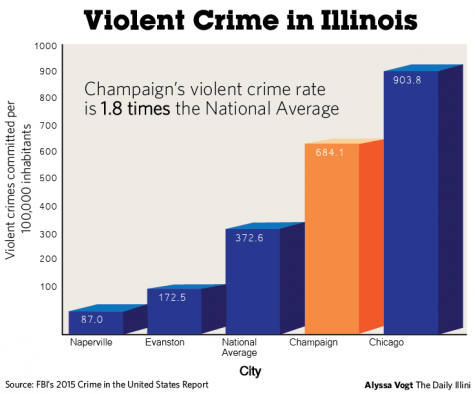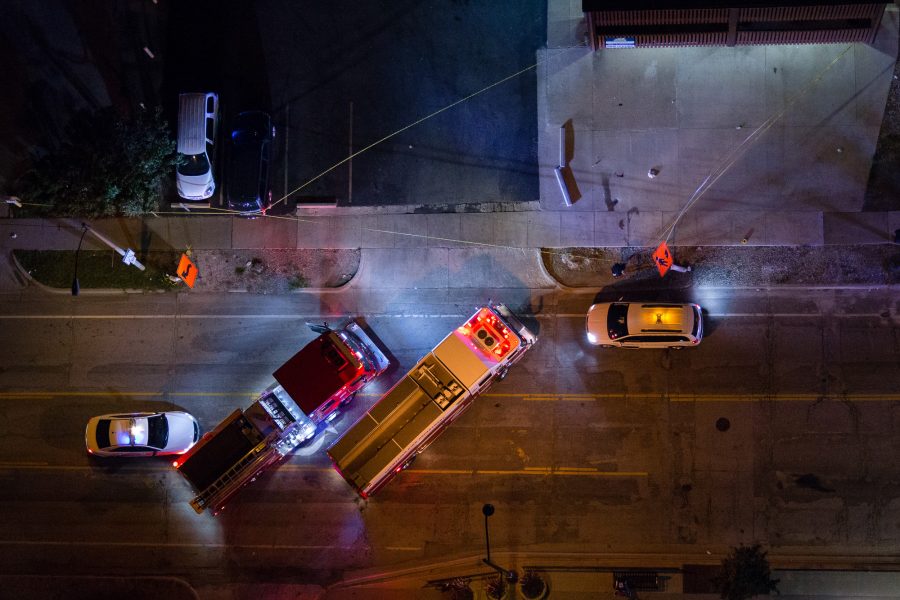Gun violence isn’t new to Champaign-Urbana
Police cars and fire trucks gather on Green Street outside of Evergreen Tobacco after the shooting.
Oct 5, 2016
To students, the University campus can often feel like a bubble closed off from the more dangerous real world. But in the early morning of Sept. 25, that bubble burst when gunshots rang out in the heart of campustown, leaving one dead and five injured.
The shooting caught many students by surprise, including Gautam Putcha, freshman in Engineering. Putcha felt very safe in Champaign before the shooting, but that feeling has since changed.
“People are feeling more and more unsafe every single day, considering that there were two shootings on the same day,” he said. “It was quite shocking to hear that.”
However, violent crime is not something new to Champaign-Urbana. According to the FBI’s newly released 2015 report, “Crime in the United States,” the city of Champaign had a violent crime rate of 684.1 crimes per 100,000 residents. This is 1.8 times the national average of 372.6 crimes per 100,000 residents.
According to the FBI, “violent crime” encompasses offenses such as murder, rape, robberies and aggravated assault. Specifically, what’s been causing Champaign the most trouble is gun-related violence, says Champaign Police Deputy Chief Joe Gallo.
Get The Daily Illini in your inbox!
“When you talk about gun violence specifically, that’s something that we’ve seen an increase in since 2012,” Gallo said.
As of Sept. 27, the Champaign Police have filed 26 “actual reports” of gun violence — designated as hard evidence of a shot being fired. In 2015, 36 such incidents occurred in the same timeframe; in 2014, 18.
“Retaliation gunfire” serves as the leading increase in firearm related incidents for the Champaign Police. Initial shootings often result in the victim grabbing a group of friends and responding with a their own shots, causing the number of actual reports to balloon.
“We’ve seen retaliation gunfire erupt where one shooting results in three additional shootings,” he said.
Gallo specified that these groups were not considered “gangs” by the police. Rather, he said they tend to be more neighborhood based, with a strong group mentality.
The shootings are mainly concentrated in the north and northwest parts of the cities, he said, which are primarily lower income neighborhoods. However, every part of the city has been affected.
“Most of the shootings have been north of University Avenue,” Gallo said. “But the problem is when you have individuals who are at odds, it’s just a matter of where they cross paths. So there’s no part of town that’s completely immune.”
Champaign Police have implemented numerous programs to try and stop the violence. The Street Crimes Task Force, established in May of 2015, targets gun violence. The task force utilizes resources from the Champaign Police, University of Illinois Police Department, Urbana Police and the Champaign County Sheriff’s Office in an attempt to reverse this trend.
“What we’re doing is we are identifying individuals who are involved in gun violence and we’re targeting them basically to get guns off the streets,” Gallo said. “We identify the groups that are at odds with each other, and we basically go after them to try to reduce the gun violence.”
This plan implements ideas created by criminologist David M. Kennedy’s “Operation Ceasefire,” detailed in his book “Don’t Shoot: One Man, a Street Fellowship, and the End of Violence in Inner-City America.”

Champaign has also taken note of another essential part of Kennedy’s book: a coordinated community driven response.
Kennedy brought felons and gang members to meetings with prominent community members to try and portray the negative effects of their violence on the local community. They then offered to assist the offenders and provided resources to change their ways if they want to take advantage of them.
Gallo recognizes that any change must begin from the individual consciously deciding to alter their ways. If they decide not to comply, the police will retaliate accordingly.
“You’re giving them a very stern warning that if they continue down this road,” Gallo said. “We’re going to use every available resource, including law enforcement, to put them in prison or drive them from the community.”
Kennedy first implemented the concept in inner-city Boston to successfully drive down crime. More recently, it has been instituted in Peoria to great effect. Champaign’s program will hold its first meeting Oct. 6.
Armed with Kennedy’s model and the Street Crimes Task Force, Gallo is confident the local law enforcement can reduce violence. Cooperation between the Champaign Police, Urbana Police, the UIPD and the Champaign County Sheriff’s office is the most effective means to accomplish this objective.
“We’re all focused on the same goal,” Gallo said. “And that’s to reduce gun violence and crime across both cities.”






